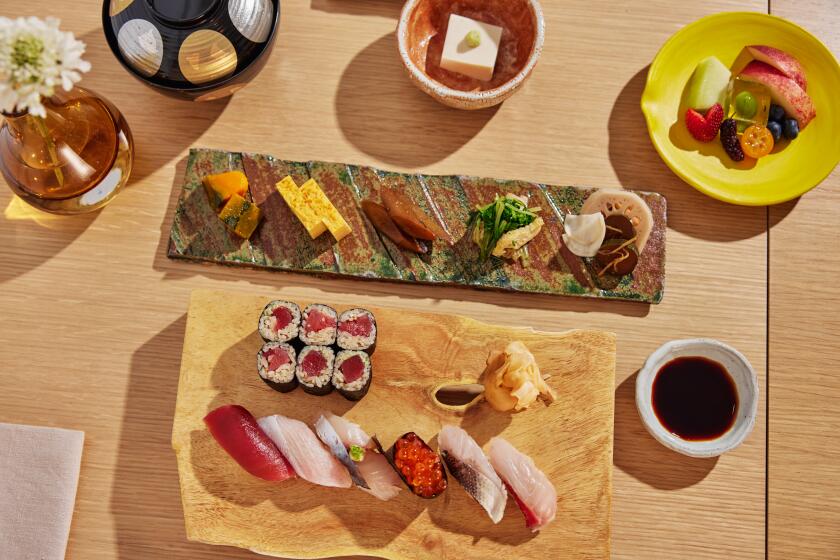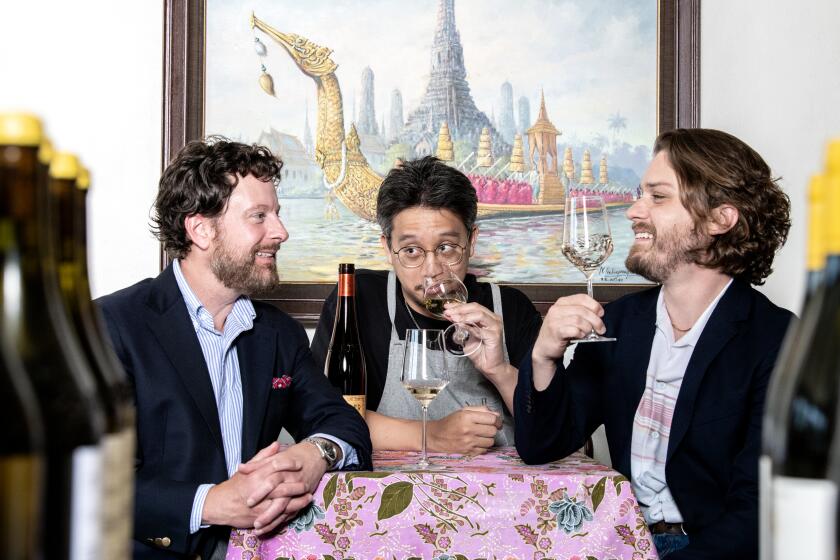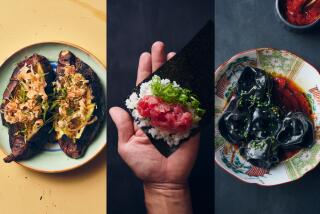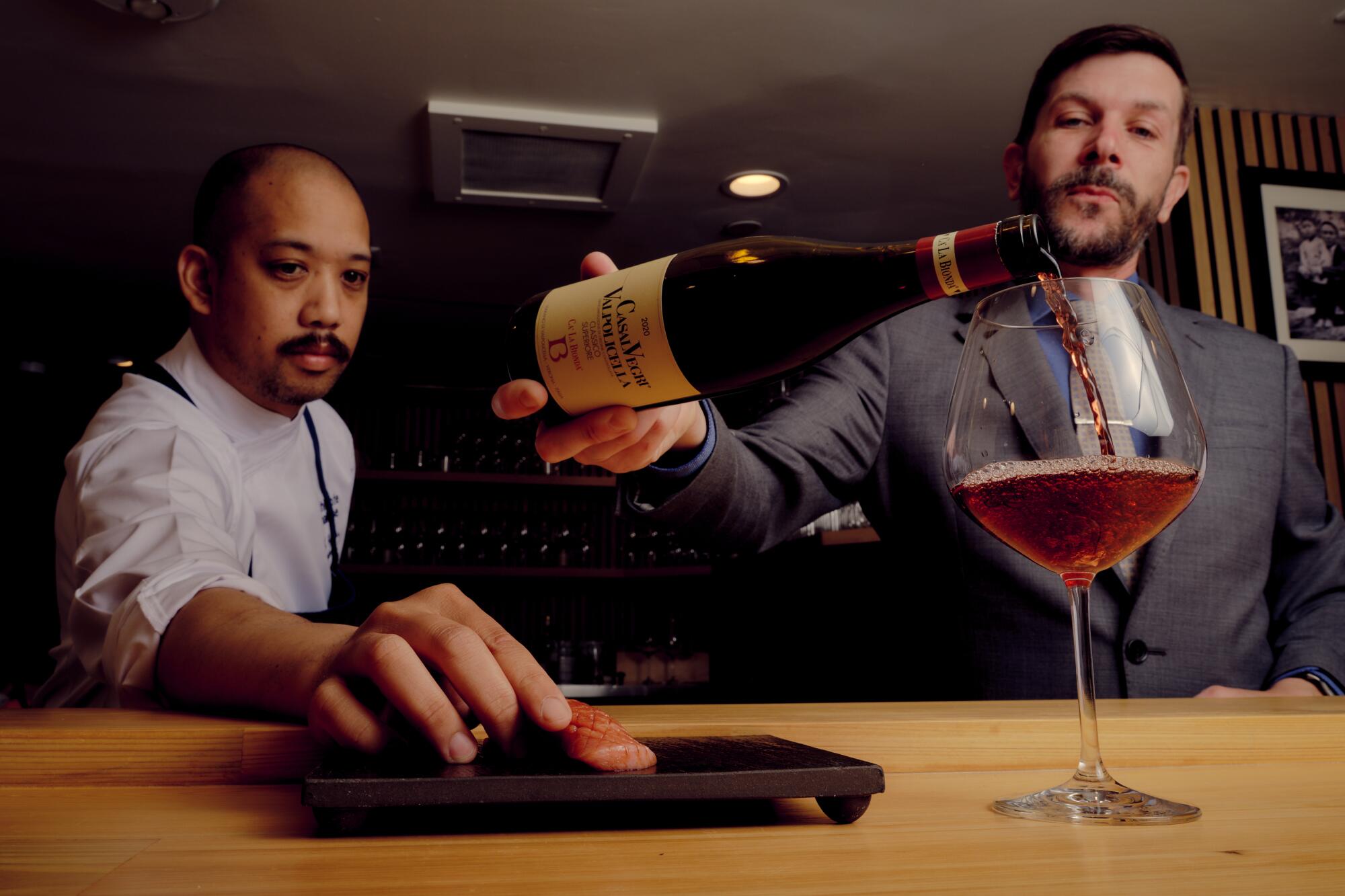
Why is pairing sushi with wine so hard?
Most sushi bars put the drinking focus on sake, and while great wine is not uncommon in a sushi setting, it has often been offered by the bottle only, from traditionally revered appellations like Champagne, Burgundy and Napa. In the last several years sushi bars have become hubs for great wine drinking, with an increasing emphasis on wine pairings.
But at the new Beverly Hills location of Sushi Note, in the Rodeo Collection parking garage beneath Givenchy and Bulgari boutiques (and at least two plastic surgery offices), the restaurant is pushing the limits of omakase sushi drink pairings. Here the focus is not on sake, whiskey, cocktails or traditional ideas about what wines go with sushi, settling instead on a kaleidoscopic barrage of obscure and esteemed wines.
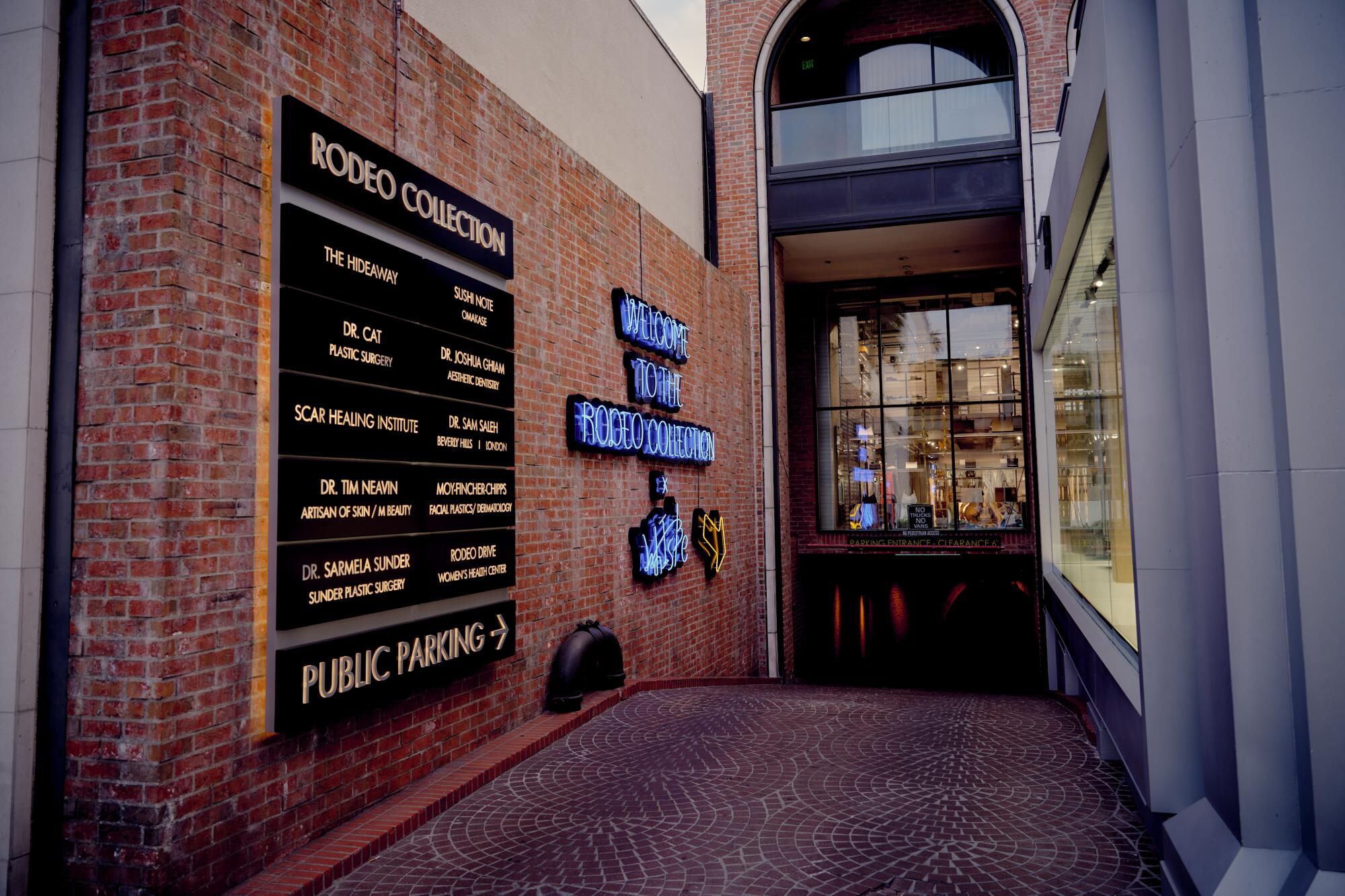
“Each fish is so distinctively different,” says Sushi Note co-founder Dave Gibbs, who operates the restaurant in partnership with Andy Paxson and sushi chef Kiminobu Saito. “We believe there’s a perfect wine to go with each one, but it takes effort and time.”
The difficulty inherent to pairings comes down to three factors: wildly varying fish, from mild, buttery albacore to briny, oily mackerel; the vinegar in sushi rice; and strongly flavored condiments such as wasabi and pickled ginger.
At Sushi Note, the process of building wine pairings involves tasting, tweaking and taking chances with different wines from around the world, incorporating the work of a sommelier team across two Sushi Note locations, including the original in Sherman Oaks. A more ambitious omakase at the Beverly Hills Sushi Note called for a more ambitious wine pairing, and that’s what you’ll find here.
From 20-course omakase tasting menus to snug sushi bars, here’s where to find the best and freshest sushi in Los Angeles.
“Every night there’s stuff we shouldn’t be pouring at all, frankly,” says Gibbs. “There’s always a featured wine that normally no businessperson with a brain would pour by the glass. It’s a straight-up loss. I’m losing money on this bottle, but it’s worth it to enhance the overall experience.”
The detail is what sets this place apart: Led by beverage director Ian Lokey, a team of more than a dozen wine experts builds out a unique wine pairing series each week, incorporating rare labels of classic wines — including Champagne and Burgundy — alongside lesser-known bottles from anywhere in the world.
Anajak Thai is a beloved so-L.A. restaurant, but it’s the sprawling list of bottles that has enamored the Sherman Oaks destination to Southern California’s wine scene.
“We employ more somms than servers,” says Lokey, whose wine list has more than 350 labels. Lokey and his team taste and compare wines alongside fish each week, working directly with culinary director Earl Aguilar and chef Saito, tasting their way through different potential combinations before arriving at a pairing that precisely matches the fusion of fish, rice and condiments for each piece of sushi. Sake, the traditional fermented rice beverage that might be more popular in America than Japan for drinking with sushi, is served sparingly, and often as a counterpoint.
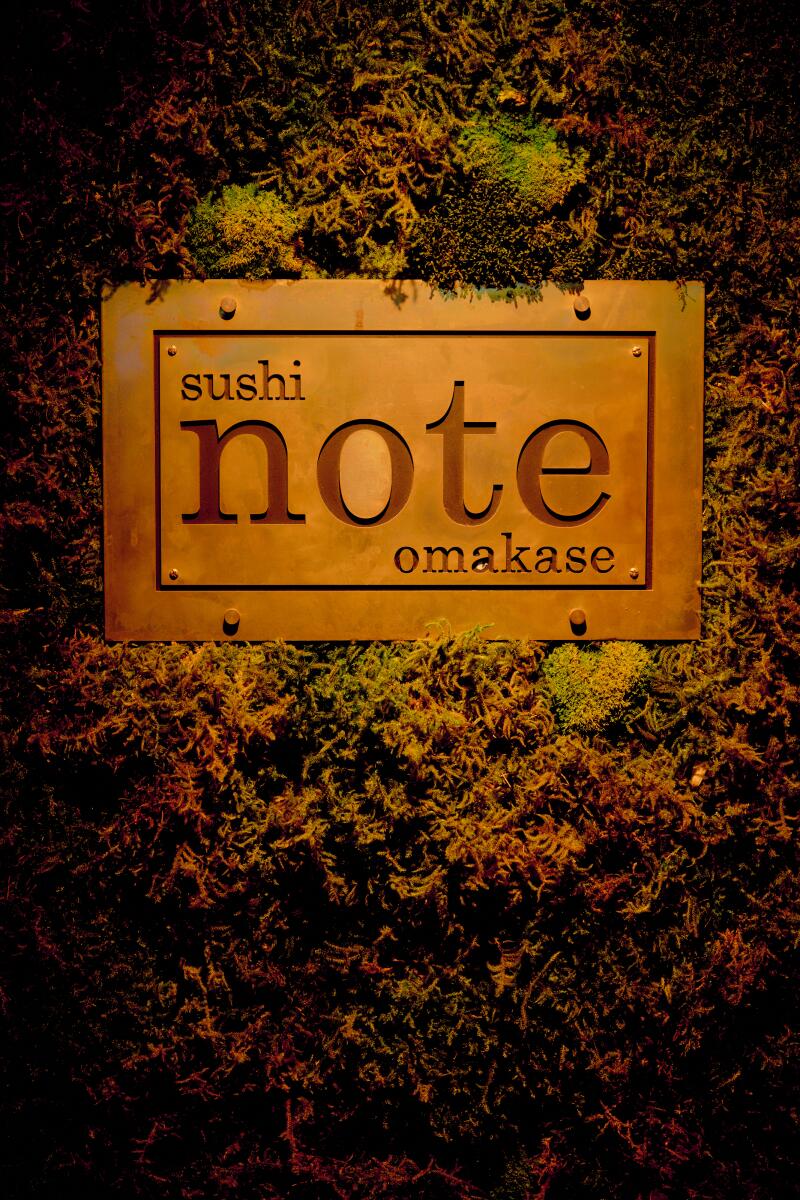
Sushi Note opened in Beverly Hills earlier this year.

Sushi Note owner Dave Gibbs with a bottle of wine from Burgundy.
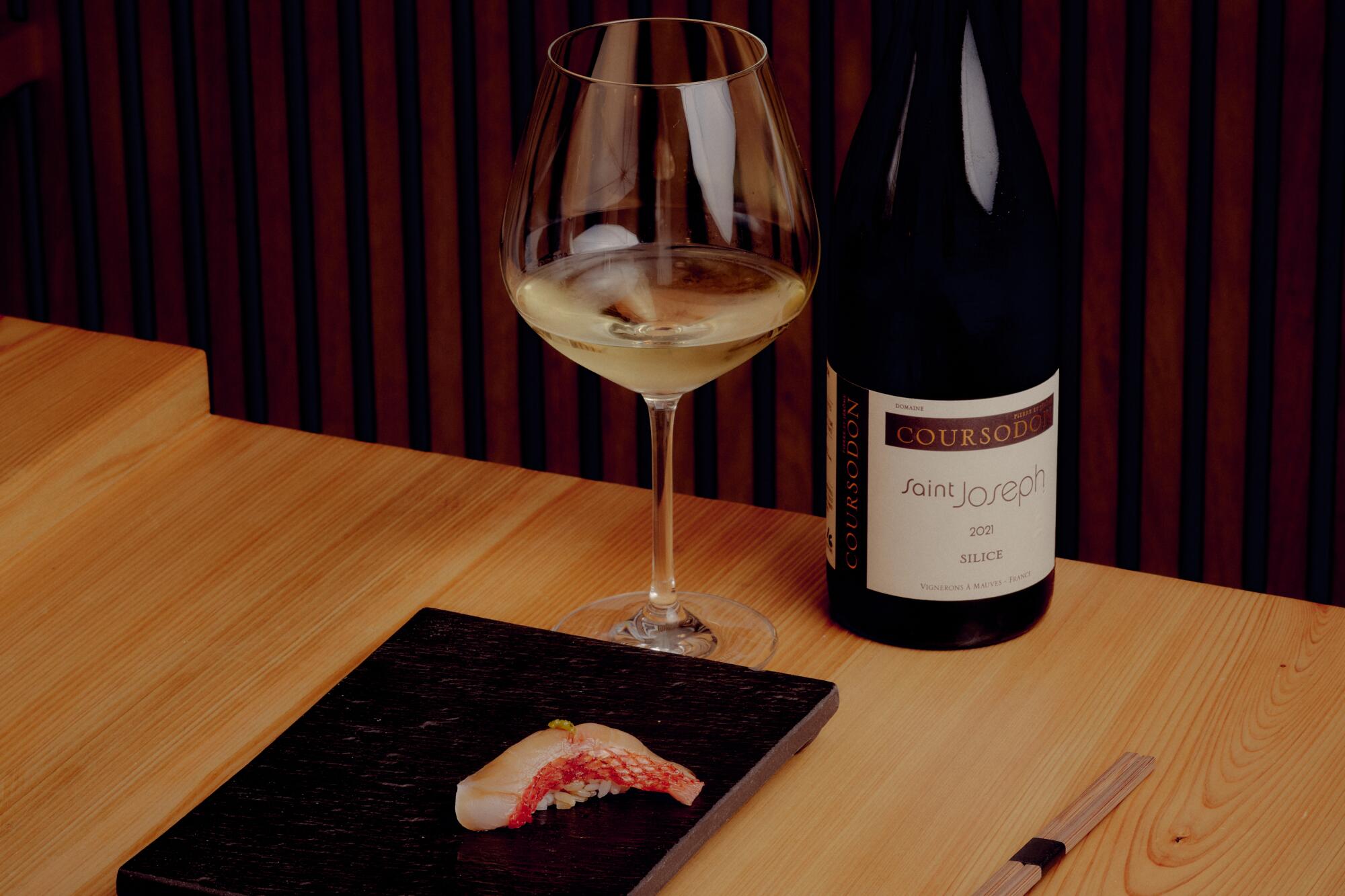
You could opt for only sake at Sushi Note — the restaurant’s bottle list gives you the option. But skipping the wine pairing here might be like dousing your chutoro with soy sauce from a little plastic packet.
Serving wine with sushi is no easy business. Restaurants such as two-Michelin-star kaiseki spot Hayato in the Arts District will accommodate guests’ requests for wine with smart pairings for its sushi courses. And the mini-chain Ootoro in Little Tokyo, Walnut and Irvine bills itself as a sushi and wine bar. Farther afield, Sushi Bar ATX in Austin and Soseki in Winter Park, Fla., have made wine service a focal point. But Sushi Note’s dedication to matching its omakase piece by piece with nightly changing wine pairings helps it to stand out in the increasingly crowded market for top-end sushi in Los Angeles, and to grow a national reputation for its brand. A third restaurant, in Las Vegas, is in development.
The right wine with the right fish
On a given night Sushi Note’s sommelier team will pour a dozen wines by the glass across the course of an omakase experience. This represents hundreds of hours of collaborative work by a sommelier team that includes Briana O’Connor, Sean Muramatsu, Jonathan Sanchez and Omar Lima, working together to find just the right wine to pair with a certain cut of fish.
“The level of oil, the garnish, the ratio of fish to rice … each of these play a factor in finding a pairing,” says Lokey.
There’s also the push-and-pull balance between fish and rice, for which the wrong wine can easily clash.
“Some of our guests are still challenged by the notion of drinking wine with sushi,” says sommelier Omar Lima, “and in particular, red wine.”

This old orthodoxy — no red wine with fish — is being directly confronted by Sushi Note, whose wine team revels in the complexity that can be found in, say, the lighter-style red wines of the Loire Valley, or high-elevation Pinot Noir. You won’t find much Cabernet being poured at Note, but light, high-toned reds can be a revelation: A natural red Cabernet Franc from Saumur sings with chutoro, while a Burgundy wine from the village of Irancy — where up to 10% of the Cesar grape is allowed alongside Pinot Noir — subtly cuts and complements a glowing piece of yellowtail, flown in direct from Japan.
In practice the experience of dining at Sushi Note in Beverly Hills is a blur — ”an arsenal of bottles,” says Omar Lima — with degrees of difficulty to the wine service that reward knowledge and interest. A 2008 Jacques Chopin Champagne, with toasted brioche notes from extended aging, is paired alongside Hokkaido uni and shiro ebi nigiri, offering layers of flavor: creamy, saline flavors from the uni, and a marked sweetness from the shrimp, all of it braced by an underlying sweet-sour texture-flavor interplay between expertly vinegared rice and toasty, bready vintage Champagne.
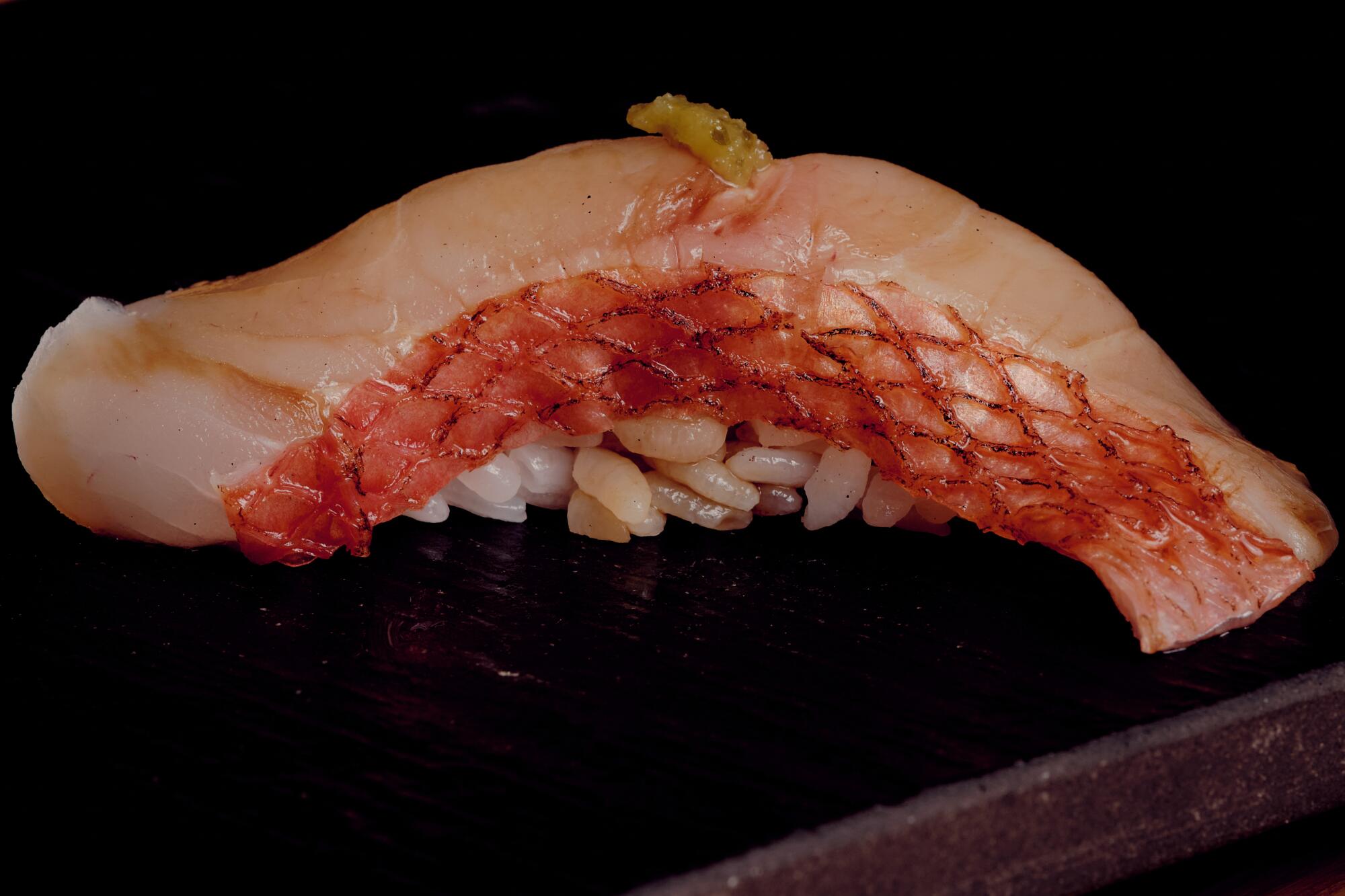
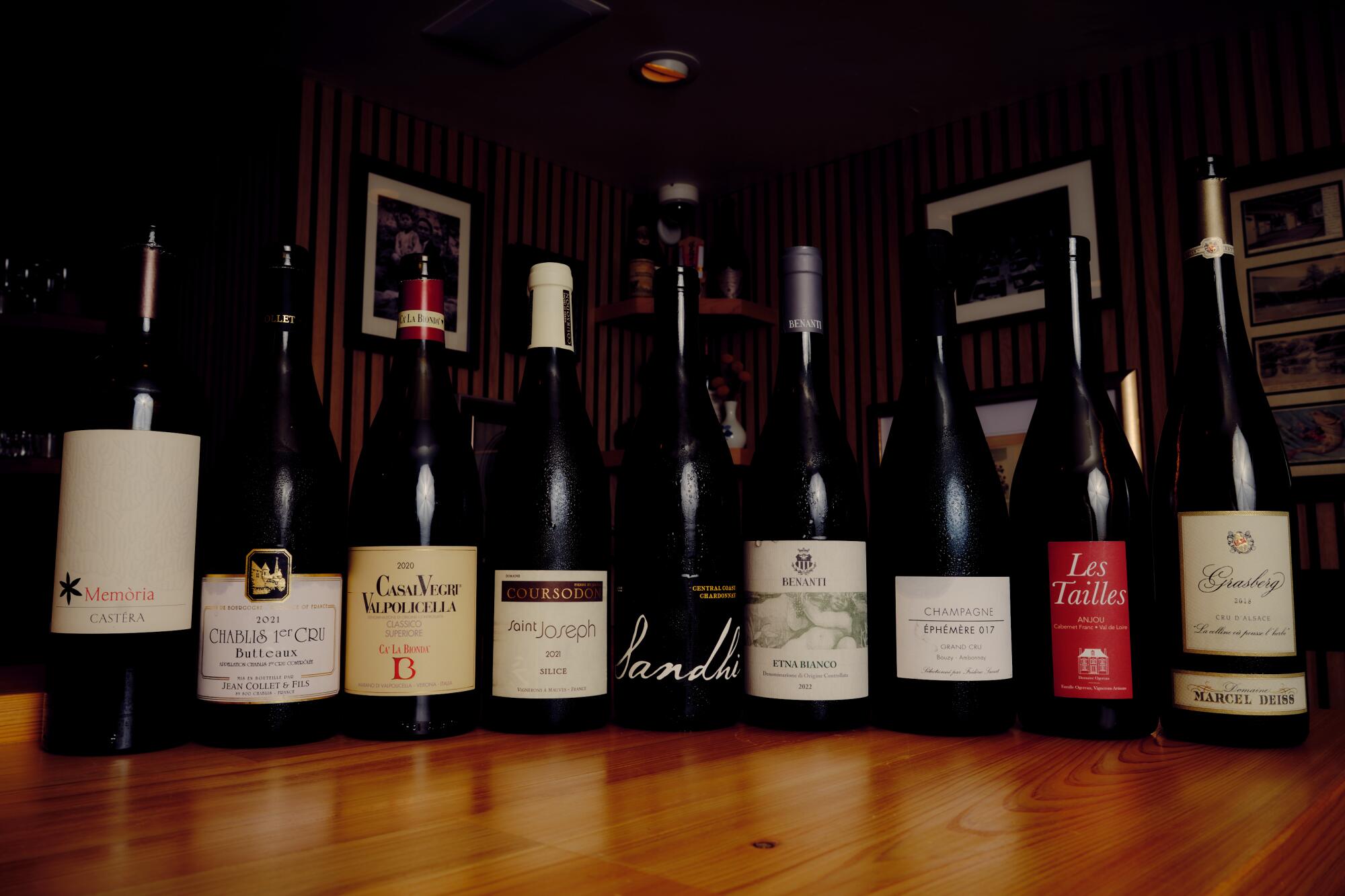
Japanese king mackerel (saba) is served with an unusual Pinot Blanc from Alsace producer Marc Kreydenweiss, a relatively unknown and rule-breaking winemaker working with an unheralded grape, paired alongside a fish that few Americans would list as their favorite sushi course, with overachieving results. The slight texture and understated funk of mackerel is cut like a lightning bolt by the Pinot Blanc, which somehow mirrors the ever-so-slightly fatty lip-smacking quality of the fish itself.
A dizzying sequence of pairings allows the concept to accrue a kind of thermal mass over the course of one omakase seating. First, a glass of Aligoté — the forgotten white grape of Burgundy that’s all the rage right now for wine geeks — alongside delicately cured red snapper.
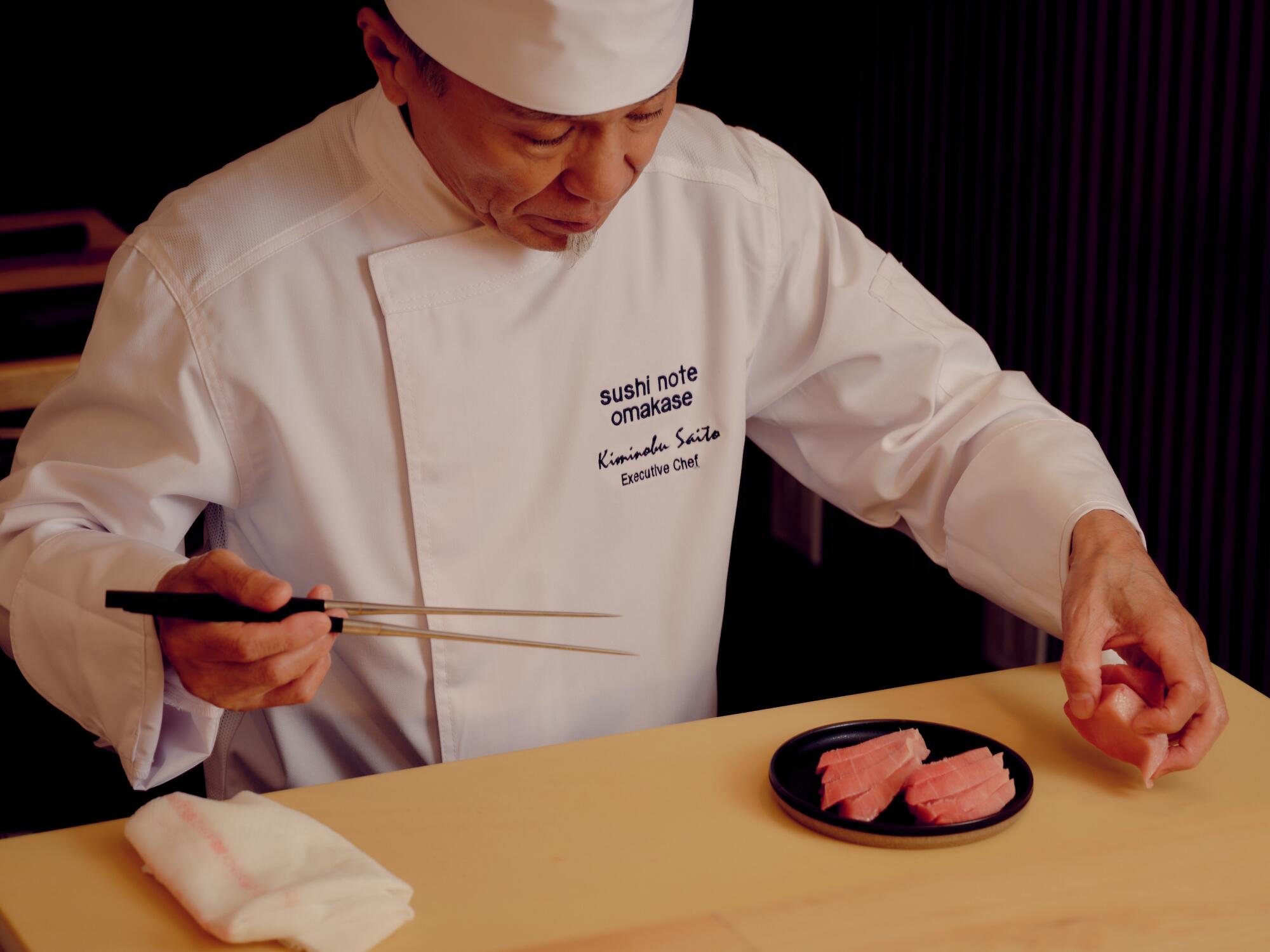
Then, one of chef Saito’s favorite pairings: Japanese wild-caught medai with a touch of yuzu, paired with Chablis, the flint-edged unoaked Chardonnay expression from the northernmost reaches of Burgundy. This is followed by Japanese bluefin otoro — the fattiest cut — served alongside a glass of Galician red wine, hailing from a corner of Spain that’s far better known for the iconic white wine Albariño but here offering a “sanguine, bloody” quality (in the words of Lokey) that sliced through the tuna as deftly as any yanagiba knife.
Finally, a yuzu and sushi rice vinegar gelato alongside Domaine Castéra “Caubeigt” Jurançon, a unique sweet white wine that hails from the far southwest of France, on the border with Spain. These wines are meant for dessert, yes, but with an electric spike of acidity that makes them unusually compelling; the combination melts into some sort of ambrosial marmalade alongside the gelato, sweet and bitter and endlessly long. “It’s the nectar of the gods,” Lima says and laughs.
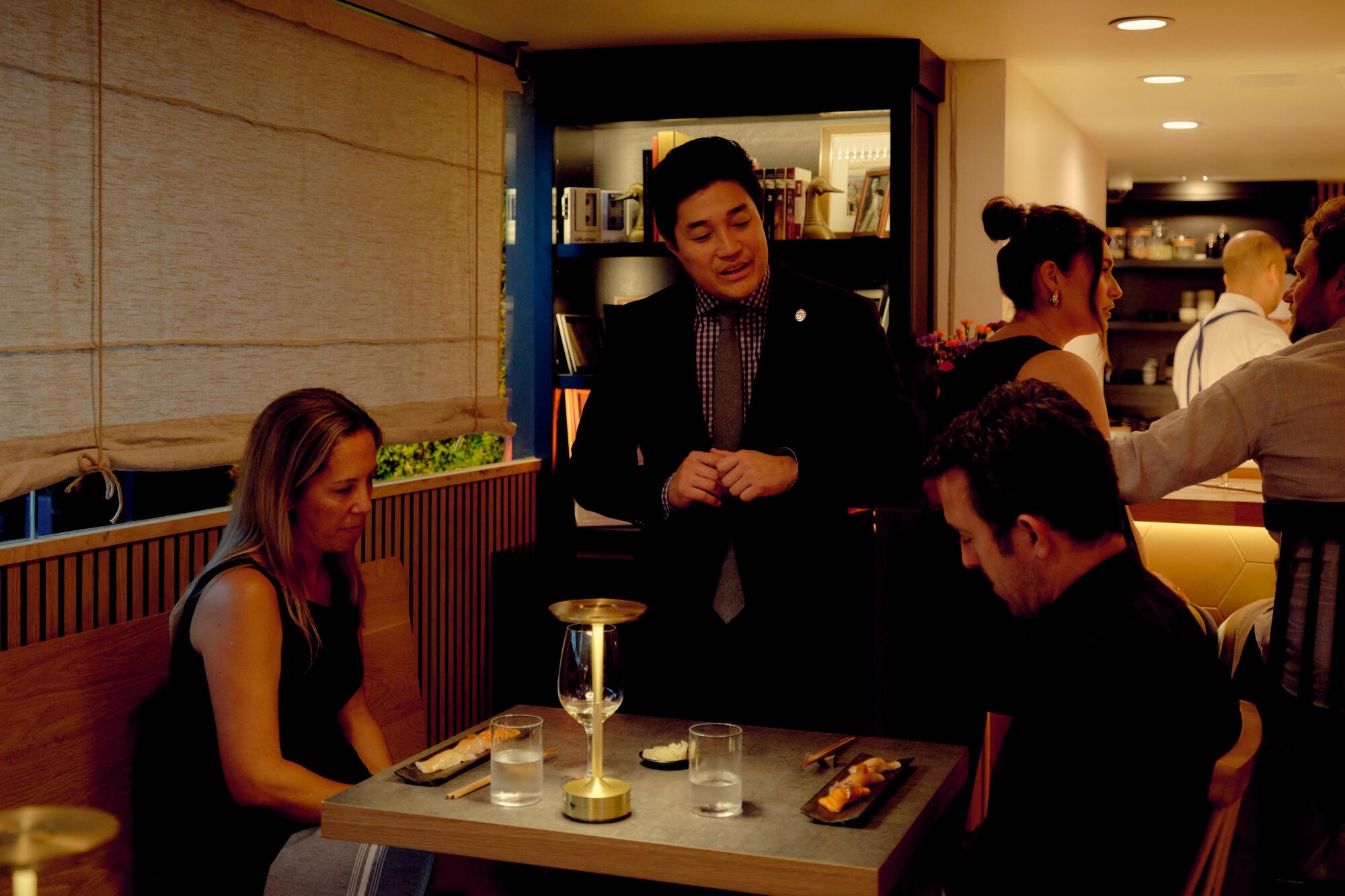
Big in Japan?
Ask the team members at Sushi Note and they’ll tell you they’re way out on a limb here — omakase wine pairing in this style is all but unknown in Tokyo, or elsewhere in the United States. To double-check I called in a ringer: Eric Asimov, longtime wine writer for the New York Times and the author of “Wine With Food,” a book dedicated to the art of food and wine pairing.
“I’ve never encountered an omakase sushi bar with wine pairings before,” Asimov tells me. Precision pairing at this level requires attention to every detail: the fish, yes, but also the condiments, the vinegar level in the rice (chef Saito’s vinegar level is softly balanced, and the grains of his rice, which hails from California, perhaps a touch larger than at other restaurants), alongside the impact of additional ingredients, the use of blowtorches to define texture, and myriad other influences that feed back to the effect of the wine, “all of which might change what might be considered the perfect pairing.”
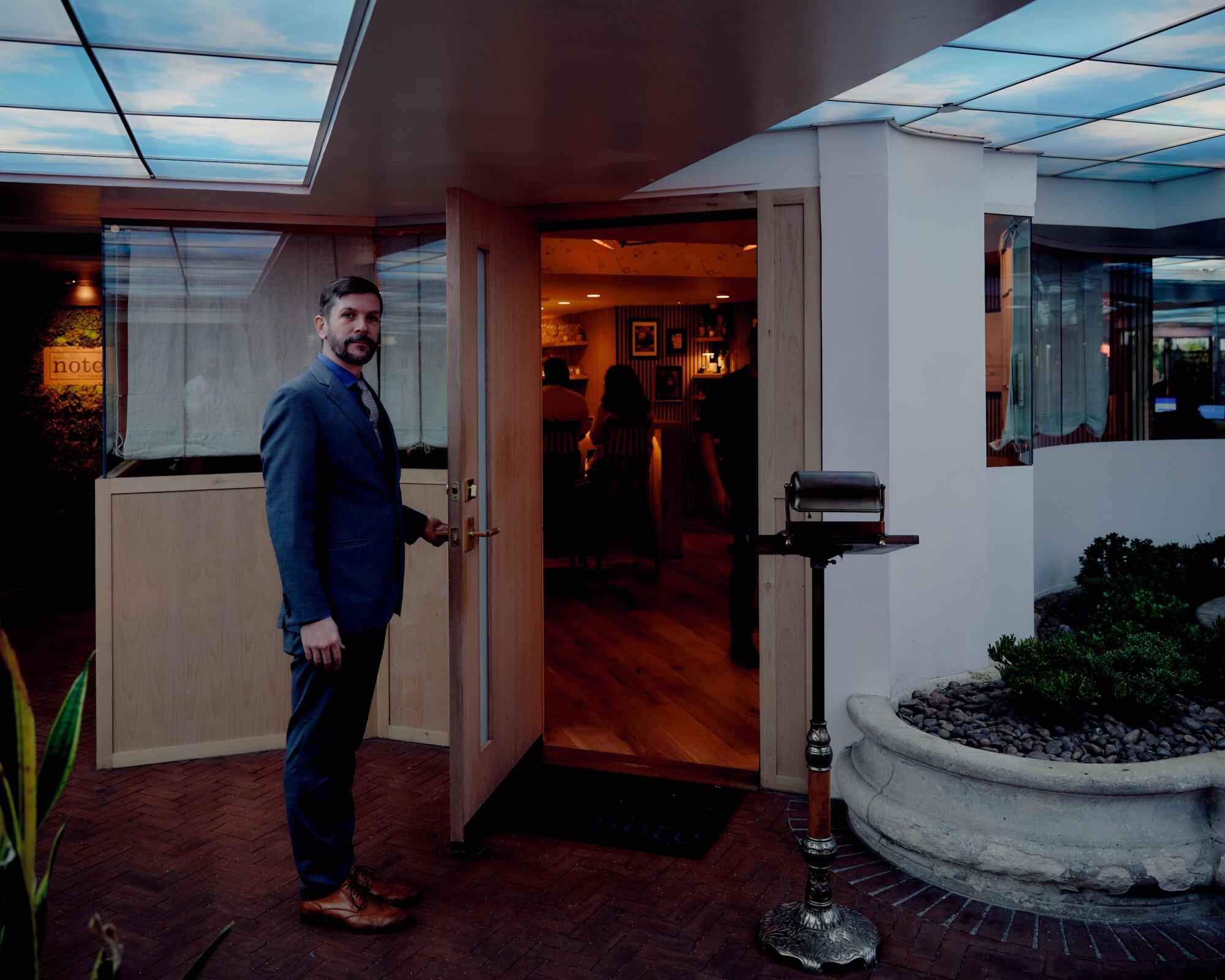
Sushi Note might be one of only a handful of places pursuing the art of precision omakase wine pairings, but perhaps not for long.
Chef Saito tells me that in Tokyo, chefs are beginning to catch up to the idea of sushi and wine pairings, and that this sort of thing might not remain a Los Angeles exclusive for long. “Many more [sushi] chefs have been experimenting with wine,” Saito says. “I can see a restaurant like ours doing very well in Japan!”
More to Read
Eat your way across L.A.
Get our weekly Tasting Notes newsletter for reviews, news and more.
You may occasionally receive promotional content from the Los Angeles Times.
